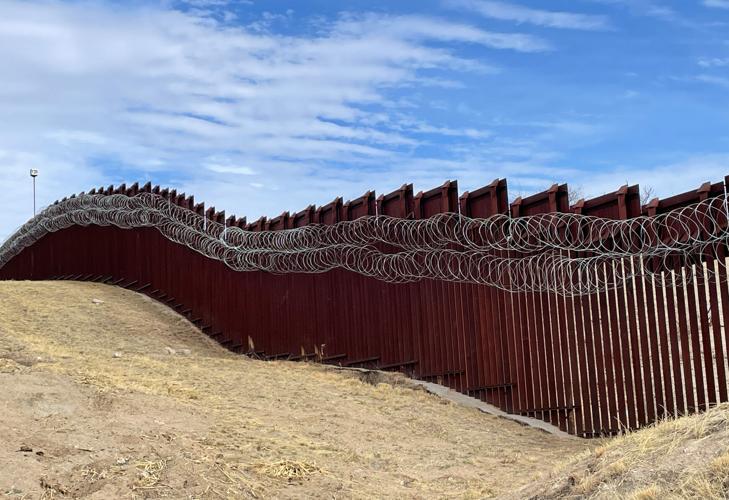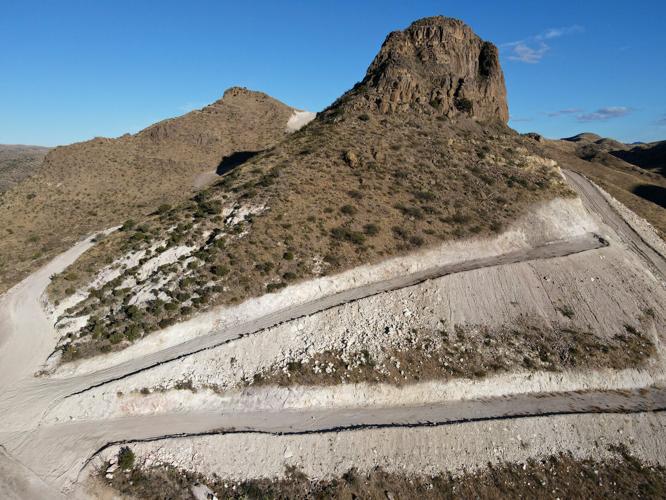The border wall in Arizona needs immediate remediation in sensitive areas to avoid serious public safety issues and significant damage to native wildlife that is likely to compound over time, according to a new report by conservation group Wildlands Network.
“Irreparable damage” has already taken place, said Myles Traphagen, borderlands program coordinator for the Wildlands Network.
“We’re never going to see Montezuma Peak at Coronado National Memorial the way that Coronado saw it in 1542,” Traphagen said. “We’re not going to see Guadalupe Canyon in the condition it was when Roger Tory Peterson, the noted birder, and Robert Stebbins, the noted herpetologist, visited these places to note rare species of birds and reptiles that only occur in that part of Arizona.”
On the day that President Joe Biden took office and halted most construction on the border wall, the nonprofit organization began assessing environmental effects of the wall and related construction in Arizona and New Mexico.
Several “crucially important wildlife corridors were saved at the last minute” when construction was halted, says the report, released Monday. However, the report continues, numerous national wilderness areas suffered “an incredible amount of damage.”
During the Trump administration, 263 miles of pedestrian fencing/border wall were built in Arizona and New Mexico, the report says. Along with the fencing that was already there, that comes to at least 391 miles of border wall, equaling about 70% of the land along the two states’ southern borders.
The report highlights some of the environmental damage and mitigation it says is needed in five protected wilderness areas in Coronado National Forest on the Arizona-Mexico border, which Traphagen says are the “most dramatic examples,” including:
Cerro del Fresnal, about 1 mile east of the Buenos Aires National Wildlife Refuge.
Pajarito Mountains, 6 miles west of Nogales.
Western Patagonia Mountains, 1 mile east of the Santa Cruz River.
Coronado National Memorial, at the southern terminus of the Arizona Trail.
Guadalupe Canyon, about 4 miles west of the New Mexico-Arizona state line.
Mitigation plans called insufficient
The report says threats to some of these areas include: rockfall, erosion, invasive plant species, choking out springs and cattle watering tanks, the risk of catastrophic flood damage, serious public safety issues, and threats to critical habitat for the endangered jaguar.
Some of the places highlighted in the report also still have construction materials on site, like Cerro del Fresnal, a prominent peak in Coronado National Forest in Pima County.
Federal contractor Fisher Sand & Gravel blasted the peak with dynamite, leaving behind construction material and debris such as rebar and steel mesh, the report says. There is no fencing or signage to warn people or to keep out animals. A commercial generator left there slid down a slope, slammed into the border wall, and was left there for at least a week, the report says.
“Cerro del Fresnal has essentially become an unmitigated mining site,” the report says, adding that the Mine Safety and Health Administration should take custody of the site.
As well, the record-breaking heat and lack of rain for the Southwest in 2020 highlights the added dangers to animal species, Wildlands Network says. In arid environments animals often need to migrate long distances in order to find water, meaning with a hotter and drier climate, animals need more space to access food and water, not less, the report says.
Using the 2005 REAL ID Act, which contains a provision that allows the secretary of Homeland Security to waive laws that interfere with construction of physical barriers at the borders, the Trump administration waived dozens of laws to speed up wall construction, including the requirement to review environmental impacts.
Noting little robust government oversight of environmental impacts, Wildlands Network began a wildlife monitoring program in late 2019 at San Bernardino National Wildlife Refuge, in southeastern Cochise County, to measure the effect of the border wall on wildlife movement across the border, setting up dozens of trail cameras in busy wildlife corridors.
Detections of wildlife on the trail cameras along the border have declined over the last year in places where a wall was built.
While the report recommends that the wall be fully removed in order to fully restore the region, it makes recommendations on ways the wall could be modified to create openings for wildlife passages.
Traphagen is doubtful the government will remove sections of wall for animals.
“Wildlife passage for large mammals is diametrically opposed to the objective of trying to keep large mammals like humans from crossing, so it’s almost like an irreconcilable difference between people who are advocating for wildlife and people who are advocating for border security,” he said. “However, the crucial difference is that most large mammals cannot get over the wall, whereas humans are still able to do that. And they do that on a daily basis using ladders, ropes and reciprocating saws.”
Incidents of people climbing the border wall are not uncommon and sometimes lead to injury and death, including a Mexican woman who choked to death on climbing gear on the border wall in Cochise County in April.
Remediation measures to start this fall
The government is planning remediation measures for wall construction areas, which have been pushed back in Arizona to the fall. They include adding more barriers rather than taking some down.
Biden’s 2023 budget request includes authority for the Homeland Security secretary to transfer up to $225 million to the Interior Department or the Forest Service for environmental mitigation activities related to the construction of the border wall.
Custom and Border Protection’s remediation plans “didn’t identify the real problem locations,” Traphagen said. The measures it outlined “serve for the protection of the border wall infrastructure,” without much consideration to environmental harms, he said.
“They never presented any photographs with descriptions of the most egregious damage,” he said.
Customs and Border Protection did not respond to questions from the Star about the Wildlands report in time for the print deadline.
The government’s remediation plans include cleaning up and repairing damage in Pima, Cochise and Santa Cruz counties, including environmentally sensitive areas in Organ Pipe National Monument, Buenos Aires and Cabeza Prieta wildlife refuges, San Pedro National Riparian Area and Coronado National Memorial.
The plans include environmental remediation like revegetation of disturbed areas as well as the installation of 8-by-11-inch wildlife passages in parts of the border barrier. Also planned are gap closure and gate installation, which is something environmental groups say will further impede the movement of wildlife.
The remediation has yet to start, but the government has begun clearing construction materials away from sites, including areas in Buenos Aires National Wildlife Refuge, where piles of gravel and dirt remain.
The Wildlands report comes on the heels of Arizona allocating $355 million for a border wall, which is unlikely to be an actual wall but rather a “virtual” one, which could include motion sensors, infrared cameras, mobile towers and aerial drones.
Razor wire can be taken down swiftly
Another significant aspect of the border barrier that the Wildlands report highlights is the 180 miles of razor wire, also called concertina wire, which was installed on the wall in border cities including Nogales, Douglas, San Diego, Calexico and El Paso in 2019 and 2020.
The report documented 64 miles of razor wire in Arizona, 46 in California and 70 in Texas.
While some of the natural places are beyond repair, “razor wire is something we can do something about,” Traphagen said.
The razor wire “threatens the residents of these cities and places children at risk to severe lacerations” and inflicts “psychological damage” to residents of border cities, the report says.
“That can be taken down swiftly,” Traphagen said. “I’m really concerned about the impact to people who live in border communities and especially children and young people who grow up in a place that is very militarized, that resembles the Berlin Wall, resembles a prison, and what is going to be the long term effect upon these young people who become normalized to that type of brutal setting.”
Wildlands Network sent the report to members of Congress and made it available to the public at wildlandsnetwork.org/news/priority-restoration-areas-border.
“We’re essentially destroying our land, our protected lands that Congress … decided to set aside for cultural and environmental resource preservation,” Traphagen said. “The border wall has so many levels. We need to reflect upon where our values are now, and is it really worth destroying our own home for trying to deal with a human socioeconomic problem.”
RELATED:
For Star subscribers: The mayor of Washington, D.C., says Arizona Gov. Doug Ducey’s migrant busing program is overwhelming migrant services in the nation’s capital and filling up D.C. homeless shelters.
For Star subscribers: The Arizona Legislature has budgeted $335 million for border barrier construction. But what will actually be built might be a combination of a virtual wall and barriers around critical infrastructure not directly on the U.S.-Mexico border, the Governor's Office says.
For Star subscribers: The number of migrants showing up at the entire U.S. border with Mexico continues to break records, as does the number who pass through Pima County needing assistance. Arizona's May numbers were also higher than previous months, though not a record.









